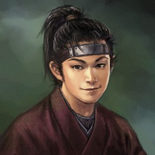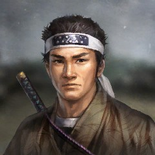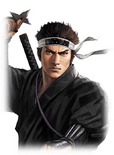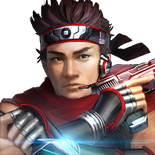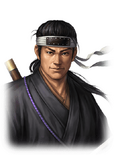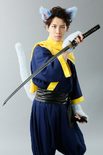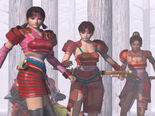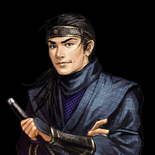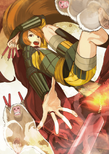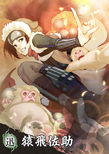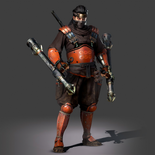| Sasuke | |
| Clan(s)/Alliance(s): | Sanada |
|---|---|
| Height: | 165 cm (5'5")
|
| Weapon(s): | Arm blades |
| Moveset Type: | Hyper
|
| Significant Battle(s): | |
| Playable Debut: | Samurai Warriors: Spirit of Sanada |
| Real name: | Sarutobi Sasuke
|
| Japanese name: | 猿飛 佐助
|
| Born: | ?
|
| Died: | ?
|
| Fictional character. Allegedly based on real life individuals like Kōzuki Sasuke (上月佐助) and Sarutobi Nisuke (猿飛仁助). Certain narratives have him die in 1615. | |
Sasuke is the name of a fictional ninja famed as one of the Sanada Ten Braves. A formidable trickster, he fought for his clan's struggles against the Tokugawa until their defeat at Ōsaka Castle.
Before his playable debut in the Samurai Warriors series, Sasuke appeared as a ninja bodyguard in Samurai Warriors 2.
Role in Games
Samurai Warriors
He is Hanzō's disciple in Samurai Warriors: Spirit of Sanada. He aids Kunoichi and the Sanada as they help escort Yukimura, Chacha and Muramatsu to safety as children. As Yukimura's matures, Sasuke joins the Sanada as an agent for the Tokugawa and he regularly reports to Hanzo.
After Hideyoshi's death, Sasuke becomes more conflicted about his loyalties. He initially distances himself from the Sanada in the lead-up to the Eastern Army's siege of Ueda but he foils Hanzō's attempt to attack Yukimura and ultimately decides to side with the Sanada, later joining them in exile. After Masayuki's death, he remains loyal to the Sanada and helps to defend at Ōsaka Castle to protect Hideyori. During the final stages of the siege, Sasuke and Hanzō duel to the death which results in the former's demise.
Kessen
Kessen portrays Sasuke as one of Yukimura's loyal kunoichi. Should Masayuki die due to an assassination attack sent by Hidetada Tokugawa, Sasuke and the other kunoichi will defend Yukimura while he mourns his father. Should Yukimura be victorious at Osaka Castle, they will charge Ieyasu's camp and slay him. Sasuke deduces that they have actually killed a double instead of the real Ieyasu. If Yukimura dies during any of the final battles, she will visit his grave to pay her respects.
Toukiden
Sasuke nonchalantly asks the protagonist in Toukiden Mononofu to set him free. He abstains from explaining how he was devoured by the demons, only interested in helping his savior fight against the Mifuchi in their path.
Character Information
Personality
Sasuke is emotionally distant from anyone other than Hanzō, whom the youth has come to see as a father figure for raising him and teaching him the ways of the ninja. However, interactions with Yukimura gives him the opportunity to open up to others.
Character Symbolism
Sasuke is symbolized by the kanji for "shadow" (影) and "flight" (飛). The namesake of Sasuke's default weapon comes from his moniker of "Monkey Jump". However, the normal spelling is reversed to say "Jumping Monkey".
His first rare weapon is named after the fire god Kagutsuchi.
Sasuke's second rare weapon refers to Sarutahiko Ōkami, ancestral leader of the earthly kami in Japanese mythology. Worshiped as a deity of purification, strength, and guidance, he helped Ninigi-no-Mikoto pacify the Earth under instructions from Amaterasu. Legends describe him as a large man with a long beard and ruddy face, though anthropologists have correlated his appearance to that of a Japanese macaque. According to the Kojiki, Sarutahiko drowned on the coast of Ise when his hand got caught in a shell while fishing. This provoked his wife Ame-no-Uzume-no-Mikoto into demanding that all sea creatures offer themselves as tribute to their family's lineage.
Voice Actors
- Erin Fitzgerald - Kessen (English)
- Youko Iwasaki - Kessen (Japanese)
- Yōhei Azakami - Samurai Warriors: Spirit of Sanada
- Junichi Suwabe - Nioh
Live Action Performers
- Kazumi Doi - Kono Nyaka ni Jinbyou ga iru nya ~ Nobunyaga no Yabou Trial Kouen
- Yuuta Iiyama - Butai Nobunyaga no Yabou Yukimura to Gorin no Ken
- Shougo Nihira - Kono Nyaka ni Jinbyou ga iru nya ~ Nobunyaga no Yabou Trial Kouen, Butai Nobunyaga no Yabou ~ Neko Gungi
- Koumei - Butai Nobunyaga no Yabou ~ Neko Gungi, Butai Nobunyaga no Yabou ~ Neko Gungi 2
- Ayumu Honda - Fighting Musical Makai
Quotes
- "Hey, it's Kunoichi. Have you been keeping up with your training?"
- "I'm busy with the real thing, so I'm not going to waste time doing that. I'm fine without it, but I can't say the same about you."
- "You sure? Look, aren't you getting a bit fat? Y'see, around here?"
- "No, no, no. You're seeing things, and you've got too much time on your hands. Ah, there's Yukimura! Later, Sasuke!"
- ~~Sasuke and Kunoichi; 100man-nin no Sengoku Musou
Gameplay
| Keys: |
Ground Moveset
 ,
,  , (
, ( ): Sasuke jumps into the air spinning his arm blades, then hops forward spinning his blades before swinging one of the blades down.
): Sasuke jumps into the air spinning his arm blades, then hops forward spinning his blades before swinging one of the blades down. ,
,  ,
,  , (
, ( ): Sasuke dashes forward piercing his right arm blade, then roll jumps detonating a bomb on the ground, then comes down swinging his blades in a diagonal X.
): Sasuke dashes forward piercing his right arm blade, then roll jumps detonating a bomb on the ground, then comes down swinging his blades in a diagonal X. ,
,  ,
,  ,
,  , (
, ( ): Sasuke dashes right swinging his arm blades across the ground, makes a trail of fire then sends it forward in a wave.
): Sasuke dashes right swinging his arm blades across the ground, makes a trail of fire then sends it forward in a wave. ,
,  ,
,  ,
,  ,
,  : Sasuke roll jumps slashing his arm blades, then kicks a blast of energy forward.
: Sasuke roll jumps slashing his arm blades, then kicks a blast of energy forward. ,
,  ,
,  ,
,  ,
,  ,
,  ,
,  ,
,  :
: : Sasuke moves swiftly forward whilst diagonally slashing his arm blades. For the finisher, he blades a large red energy wave, then spins in midair slashing his arm blades, then sends a large shockwave forward.
: Sasuke moves swiftly forward whilst diagonally slashing his arm blades. For the finisher, he blades a large red energy wave, then spins in midair slashing his arm blades, then sends a large shockwave forward. (Ultimate/Kaidan): Sasuke warps around in midair, slashing enemies rapidly.
(Ultimate/Kaidan): Sasuke warps around in midair, slashing enemies rapidly. ,
,  :
: ,
,  :
:
- Deadlock Attack & Mighty Strike: Sasuke swings his arm blades at the front of the enemy, then warps behind and cuts his/her back, knocking him/her away.
Hyper Moveset
 ,
,  : Sasuke hops forward swinging his left arm blade up.
: Sasuke hops forward swinging his left arm blade up. ,
,  ,
,  : Sasuke sends an energy circle forward.
: Sasuke sends an energy circle forward. ,
,  ,
,  ,
,  : Sasuke roll jumps and slashes his arms blades diagonally on landing.
: Sasuke roll jumps and slashes his arms blades diagonally on landing. ,
,  ,
,  ,
,  ,
,  : Sasuke handstands and kicks while making a tornado.
: Sasuke handstands and kicks while making a tornado. ,
,  ,
,  ,
,  ,
,  ,
,  : Sasuke dashes forward slashing his arm blades two times.
: Sasuke dashes forward slashing his arm blades two times. ,
,  ,
,  ,
,  ,
,  ,
,  ,
,  :
: ,
,  ,
,  ,
,  ,
,  ,
,  ,
,  ,
,  :
: ,
,  ,
,  ,
,  ,
,  ,
,  ,
,  ,
,  :
:
Horse Moveset
Weapons
| Monkey's Fang | |||
|---|---|---|---|

|
Base Attack: 13~33 | ||
| Luminous Barbs | |||

|
Base Attack: 249 | Fire: 83 | Death: 78 |
| Attack Up: 81 | Attack Range: 85 | Attack Speed: 87 | |
| Courage: 76 | Verity: 77 | Momentum: 90 | |
| Divine Saruhiko Claws | |||

|
Base Attack: 256 | Wind: 86 | Death: 81 |
| Attack Up: 84 | Attack Range: 88 | Indirect Attack: 89 | |
| Underdog: 84 | Insight: 83 | Clarity: 87 | |
Rare Weapon Acquisition
- Stage: Ōsaka Summer Campaign - Battle of Dōmyōji
Japanese Folklore
Creation
Sarutobi Sasuke is the creation of multiple fictional Japanese novels. The earliest known published inspiration for him comes from the late Edo period novel, Sanada Sandaiki, a romanticized narrative of Masayuki, Nobushige (Yukimura), and Nobushige's eldest son, Daisuke (Yukimasa), defying the Tokugawa shogunate. At the time of its publication, anti-shogunate sentiments were steadily becoming commonplace in the face of the shogunate's controversial rulings. Celebrations of a time before the Tokugawa shogunate began to gain popularity, especially those from the Warring States period.
Within the Sanada Sandaiki, there was the earliest known concept of the "Sanada Ten Braves", ten heroic named figures who served the three key figures. Sasuke was a deemed one of them who fought to the bitter end for Nobushige during the final Osaka Castle campaign. Kanda Hakuryū, the author of the fictional Nanba Senki, would repeat the tales of the Sanada Ten Braves in his narrative and added the "Sarutobi" (translated literally as "Flying Monkey") nickname to Sasuke, along with his purported rivalry and friendship with Kirigakure Saizō. His full name as a samurai in this story was "Sarutobi Sasuke Yukiyoshi" (猿飛佐助幸吉), his given name signifying his loyalty to Nobushige (Yukimura) and Hideyoshi. Enshoku Taihei Raki, a fictional historical narrative published in 1731, lists Sasuke by name as one of Nobushige's retainers who joined his lord into exile.
The shinobi Sasuke was supposedly an addition done during the late Edo and early Meiji period, when the validity of the Sanada Ten Braves was being questioned. Regardless of its authenticity, one of Sasuke's alleged inspirations for this change is argued to be Kōzuki Sasuke (Shimotsuge no Kizaru), a shinobi famed to use magic to manipulate monkeys to do his biding. This shinobi was said to have valiantly defied Hattori Hanzō's task force with ninja techniques after the Summer Osaka Campaign. Alternatively, the shinobi version has been said to have no clear link to history besides being a reflection of what was popular in fiction at the time of its inclusion. He was retroactively associated with Kōga ninja to contrast the Iga ninja for the Tokugawa. Proponents for this interpretation prefer to state that Sasuke is a Japanese Sun Wukong, as he is a crafty and reliable guardian to his Sanzang-Fashi (Nobushige).
Two Japanese book publishers are responsible for Sasuke's continued popularity into modern times: Tatsukawa Bunko and Matsumoto Kinkado. Both companies compiled Sasuke's legends into a series of historical narratives marketed towards children of the Taishō period. These well-known heroic legends were often presented to be real, leading to the popularization of many myths which still survive in modern fiction and folklore today. Sasuke was one of three figures of the Sanada Ten Braves who received special treatment and was coined as one of the "Sanada Three Heroes". The shinobi Sasuke of today often finds his origins from these compilations.
Scholars and literary critics agree that Sasuke is fictional, but to what degree has been a subject of debate. Shiba Ryōtarō remarked that similar myths were said to have existed around Osaka before these key novels' publication. He ventured the possibility of the legends being "half-truths" due to the Tokugawa shogunate's notorious reputation of censoring any historical records against them. Various historical models for Sasuke have been claimed by authors throughout the ages, but historians have yet to universally concur with their sentiments.
Life and Death
Sasuke's popularized origins is that his father was Washio Sadayū, a retainer of Mori Nagayoshi. After Komaki-Nagakute led to his lord's demise, Sadayū decided to settle in Shinano. He fathered two children: an elder daughter named Sayo and a younger son named Sasuke. As soon as he could walk, Sasuke liked to play with the monkeys at Mount Togakushi. He learned from his animal friends to move with unsurpassed agility, a talent which attracted the attention of a Kōga shinobi known as Tozawa Hakūnsai. Hakūnsai took the young boy under his wing and taught him Kōga techniques at a village along Torii Pass for three years, a place which has been a fabled training ground for Sanada ninja. During his intensive training, Sasuke had a chance encounter with Nobushige. Impressed by the young lord's character, he swore loyalty to Nobushige henceforth.
Another proposed origin for Sasuke is that there was two of them. Washio Sadayū was actually the first Sasuke who died fighting at Mount Temoku against the Oda. His successor was a young man named Ibe Busuke, another Kōga shinobi who formerly served the Echizen Saitō clan. When his masters perished, he wandered the land and served several lords before siding with the Toyotomi forces. He had the power to control animals, especially shiba inu, which was said to mirror the first Sasuke's abilities enough to inherit the moniker. The second Sasuke served under Ōtani Yoshitsugu before Sekigahara, helping his lord swiftly communicate with allies by sending messenger birds across the land. Surviving Sekigahara but without a lord, he wandered again until he sided with Nobushige's forces for the Osaka Campaign.
Shinkun Kiyomasa Jikki, a war narrative based on Katō Kiyomasa's writings, presents another version of Sasuke. A Sarutobi Nisuke was entrusted with 3,000 rogues to assist Kinoshita Tokichirō's defense at Kanegasaki. Sarutobi was a bandit and a fond acquaintance of Hibino Rokudayū, one of Hachisuka Koroku's vassals. Through Rokudayū, Sarutobi decided to live a life of service under Hideyoshi. Sasuke was Sarutobi's grandson who inherited the Sarutobi moniker from Nisuke. Alternatively, it has been argued that Nisuke is Sasuke who served Nobushige at an old age.
Sanada Sandaiki has Sasuke as a skilled if flamboyant actor. He could conceal his appearance in the battlefield and attack without ever having to show himself. In many stories, Sasuke is a clever shape-shifter who excels in disguises and trickery. He is often unmatched in speed and strength, which leads to him clashing with the similarly skilled Saizō.
His servitude to Nobushige is inevitable in fiction. Regardless of when he serves the Sanada, Sasuke is soon ordered by his master to gather intelligence for him. Traveling from every corner of the land, he successfully infiltrated Sunpu Castle and Edo Castle (Ieyasu and Hidetada's main keeps) without raising suspicion; his reports were said to have been invaluable to Nobushige's strategies during his exile and at Osaka Castle. Before he faithfully returned to his lord, Sasuke saved many fair maidens and innocent children by crushing various bandit hideouts during his journey.
His fate at Osaka appears to vary by the narrative. Sanada Sandaiki has him be one of the survivors, escorting the real Nobushige and Daisuke away from the conflict and living with them in Satsuma. Modern day stories may prefer to have him die with his lord in the fighting around Osaka Castle like other members of the Sanada Ten Braves.
Gallery
Gallery
|
|---|
100man-nin no Nobunaga no Yabou portrait Nobunaga no Yabou 201X portrait Chartobi Sasuke in Samurai Cats Guruguru Dungeon Nobunyaga portrait
|
| This Samurai Warriors related article is a stub. You can help the wiki by expanding it. |





